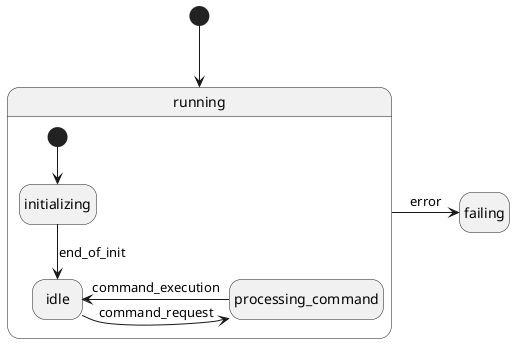Definition
A composite state is a state that contains its own set of nested states and transitions. Like a state machine, a composite state has exactly one active state (unless it's made of several regions).
In example below, running is a composite state:

Whenever a state machine enters a composite state, it also enters the initial state (initializing in our example) of that composite state. Whenever a state machine exits a composite state, it also exits the active state of that composite state.
A state that belongs to a composite state is called a substate. A substate can also be composite, turning a state machine into a tree of states.
Whenever a substate is active, all its parent states, or superstates, are considered active as well.
When to Use a Composite State
The need of a composite state can arise from two distinct situations:
- A state implements a subsystem of its own that is complex enough to require organizing; i.e. for the exact same reasons you used a state machine for your whole system in the first place.
- A set of states can be logically grouped and share transitions to the same other states.
For example, an initializing state could be turned into a composite state if it manages the initialization of several components, each of which could be handled by a substate.
Another example: a set of states could be grouped into a composite state running if they all transition to a failing state whenever an error occurs.
How to Define and Use a Composite State with Maki
You make Maki create a composite state just like you make it create a simple state: by defining a maki::state_mold. A state becomes composite as soon as you give it at least one transition table, which you do by calling maki::state_mold::transition_tables().
- Important
- When the same state mold is referenced in several transition tables (e.g. the table of a composite state and the table of the state machine root), it's used to make several, independent maki::state objects.